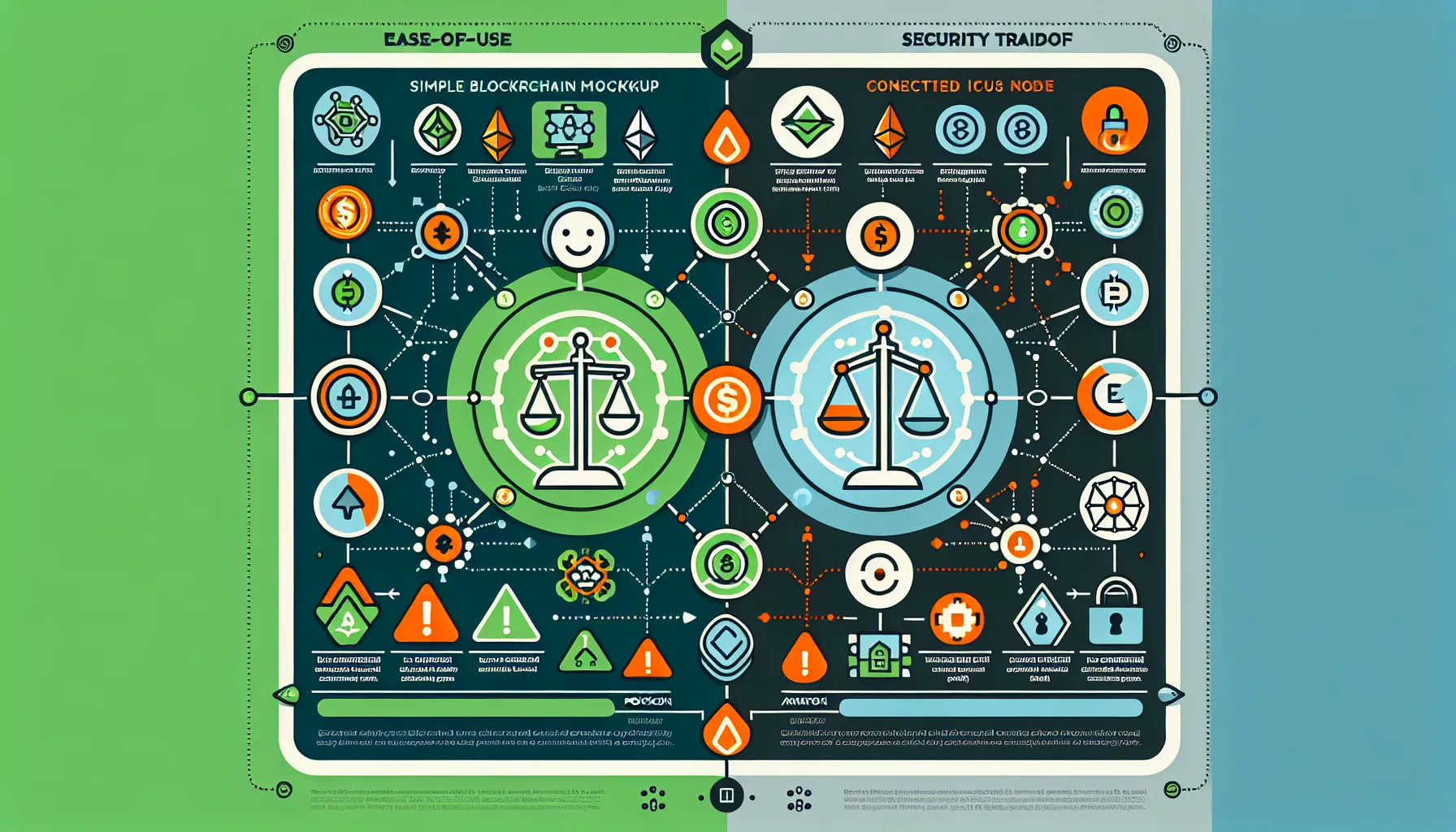The world of blockchain is no longer confined to isolated networks. As decentralised finance (DeFi) grows, so does the need to move assets seamlessly between Ethereum, Solana, Cosmos, and dozens of other ecosystems. That’s where cross-chain bridges come in, specialised protocols designed to connect blockchains and allow users to transfer tokens, data, and liquidity across different networks.
But here’s the challenge: not all bridges are created equal. Some prioritise user-friendliness with simple interfaces and fast transactions, while others lean heavily into security with trust-minimised architectures and decentralised validation. For newcomers, ease of use matters most. For seasoned DeFi participants or institutional players, security takes precedence.
This article ranks seven of the most popular cross-chain bridges from easiest to most secure, examining how each balances usability, speed, and protection against hacks or exploits. Whether you’re bridging tokens for the first time or evaluating infrastructure for serious DeFi strategies, understanding these trade-offs is essential for making informed decisions in an increasingly interconnected blockchain landscape.
Key Takeaways
- Cross-chain bridges enable seamless token transfers between blockchains like Ethereum, Solana, and Cosmos, but vary significantly in ease of use and security.
- Beginner-friendly bridges such as Multichain and Synapse Protocol prioritise simplicity and speed, though they rely on centralised validators that introduce security risks.
- Mid-tier options like Celer cBridge, Stargate Finance, and Hop Protocol balance user experience with enhanced security features, including proof-of-stake validation and decentralised guardians.
- Trust-minimised bridges like Connext and IBC (Inter-Blockchain Communication) offer superior security through decentralised architectures, making them ideal for large transactions despite steeper learning curves.
- Choosing the right cross-chain bridge depends on your priorities—beginners benefit from ease of use, whilst experienced DeFi participants and institutions should prioritise security and trust minimisation.
1. Multichain: The Beginner-Friendly Option

Multichain (formerly known as Anyswap) has built its reputation as one of the most accessible cross-chain bridges for users new to DeFi. It supports dozens of blockchains and enables straightforward token transfers without requiring deep technical knowledge.
Why It’s Easy to Use
Multichain’s interface is clean and intuitive. Users simply select the origin and destination chains, enter the token amount, and confirm the transaction. The platform supports a broad range of blockchains, including Ethereum, Binance Smart Chain, Polygon, Avalanche, and Fantom, making it versatile for those exploring multiple ecosystems.
The bridge abstracts much of the complexity away from the user. There’s no need to understand validator mechanics or interact with multiple wallets across chains. Token swaps happen with minimal input, and the process feels closer to using a centralised exchange than a decentralised protocol. For beginners dipping their toes into cross-chain DeFi, Multichain removes many of the usual friction points.
Security Trade-Offs
The simplicity Multichain offers comes with notable security compromises. The protocol relies on a set of validators to approve and process cross-chain transactions. Whilst this delegation speeds up bridging, it introduces centralisation risks. A small group of validators represents a single point of failure, if compromised, user funds can be at risk.
Multichain has faced security challenges in the past. Vulnerabilities and exploits have exposed the bridge to attacks, highlighting gaps in its architecture. Although regular security audits are conducted, the validator-centric model inherently carries more risk than fully decentralised or trust-minimised alternatives.
For users prioritising convenience and planning smaller transactions, Multichain is a solid starting point. But, those moving significant value or concerned about centralisation should weigh these trade-offs carefully.
2. Synapse Protocol: Balancing Simplicity and Speed
Synapse Protocol sits comfortably in the middle ground between ease of use and security. It’s designed for DeFi users who want a streamlined experience without sacrificing too much on the safety front. With support for over 15 blockchains, Synapse has carved out a niche as a go-to bridge for cross-chain liquidity.
User Experience Highlights
Synapse’s design prioritises intuitiveness. The interface guides users through the bridging process with clear prompts and minimal jargon. Whether you’re moving stablecoins from Ethereum to Avalanche or bridging native tokens to Arbitrum, the steps are straightforward and the waiting times reasonable.
What sets Synapse apart is its flexible liquidity pool model. The protocol taps into liquidity across multiple chains, enabling relatively fast and cost-effective transfers. For users active in DeFi, swapping between chains to chase yield or arbitrage opportunities, Synapse offers a balance of speed, coverage, and usability that appeals to intermediate traders.
Security Model Overview
Synapse employs multi-party computation (MPC) validators to approve cross-chain transactions. This approach distributes trust across multiple parties rather than relying on a single centralised entity, reducing the risk of unilateral control or malicious behaviour.
The protocol undergoes regular security audits and has implemented bug bounty programmes to incentivise ethical hackers to disclose vulnerabilities before they can be exploited. Past bugs have been identified and patched relatively quickly, demonstrating a proactive stance on security.
That said, Synapse isn’t immune to risk. The MPC model, whilst more decentralised than Multichain’s validator set, still involves delegated trust. Users should view Synapse as a practical middle option, more secure than the simplest bridges, but not yet at the trust-minimised level of more advanced protocols.
3. Celer cBridge: Fast Transfers with Growing Security
Celer cBridge has established itself as one of the most expansive cross-chain bridges in the space, supporting over 40 blockchains and layer-2 solutions. Its focus on liquidity optimisation and speed makes it a favourite amongst active DeFi participants.
Liquidity Network Advantages
Celer’s standout feature is its extensive liquidity network. The protocol routes transfers intelligently, selecting paths that optimise both speed and cost. This flexibility allows cBridge to handle a wide variety of tokens across numerous chains without users needing to worry about liquidity shortages or prohibitively high fees.
The platform’s interface is polished and responsive. Users can quickly compare routes, view estimated fees, and complete transfers in a matter of clicks. For those frequently moving assets between chains, whether for yield farming, NFT purchases, or portfolio rebalancing, cBridge’s speed and coverage are significant advantages.
Security Features
Celer has made notable strides in enhancing its security posture. The protocol integrates proof-of-stake (PoS) validation mechanisms, where validators must stake tokens to participate in transaction approvals. This economic alignment incentivises honest behaviour, as malicious actions could result in slashed stakes.
Also, cBridge employs decentralised guardians, independent actors who monitor cross-chain messages and can halt suspicious activity. This multi-layered approach reduces the risk associated with compromised validators or single points of failure.
Whilst cBridge isn’t fully trust-minimised, its evolving security architecture represents a meaningful step up from simpler bridges. Users benefit from both practical usability and a growing emphasis on decentralised oversight.
4. Stargate Finance: LayerZero-Powered Efficiency
Stargate Finance leverages the LayerZero protocol to deliver one of the most efficient cross-chain bridging experiences available. Its unified liquidity model and robust messaging framework make it a compelling choice for DeFi traders seeking speed and reliability.
Unified Liquidity Model
Stargate pools liquidity across multiple blockchains into unified reserves, creating deep markets for popular assets like USDC, USDT, and ETH. This design allows for ultra-fast swaps with minimal slippage, even for larger transactions. Users can move stablecoins between Ethereum, Avalanche, Polygon, and other chains almost instantaneously.
The unified liquidity approach also reduces fragmentation. Rather than relying on isolated pools per chain, Stargate aggregates resources, improving capital efficiency and reducing the likelihood of liquidity bottlenecks. For traders executing time-sensitive strategies or arbitraging across chains, this model delivers tangible performance benefits.
Security Architecture
Underpinning Stargate is LayerZero, a cross-chain messaging protocol built with security and decentralisation in mind. LayerZero employs a dual-validation model involving independent oracles and relayers, ensuring that cross-chain messages are verified by multiple parties before execution.
This decentralised approval network enhances trust and resilience. Even if one component is compromised, the protocol’s architecture prevents single points of failure from jeopardising user funds. Stargate’s integration with LayerZero positions it as one of the more secure options amongst user-friendly bridges.
Whilst Stargate demands slightly more blockchain literacy than Multichain or Synapse, its combination of speed, liquidity depth, and security makes it an excellent choice for intermediate to advanced users.
5. Hop Protocol: Optimistic Rollup Specialist
Hop Protocol has carved out a specialised niche by focusing on Ethereum and its layer-2 rollups, Arbitrum, Optimism, Polygon, and others. Its unique bonder system enables near-instant transfers, making it a preferred bridge for users navigating the Ethereum scaling ecosystem.
How Hop’s Bonder System Works
Hop’s architecture revolves around “bonders”, intermediaries who provide liquidity upfront to users bridging between chains. When a user initiates a transfer, a bonder fronts the funds on the destination chain, allowing the user to receive tokens almost immediately. Later, the protocol reconciles the transaction on-chain, reimbursing the bonder.
This model dramatically reduces wait times compared to traditional bridges that rely on block confirmations across multiple chains. For users moving assets between Ethereum mainnet and rollups, or between rollups themselves, Hop delivers a seamless, rapid experience.
Enhanced Security Mechanisms
Hop Protocol employs decentralised bonding and multi-signature authorisation to secure its operations. Bonders must lock collateral, aligning their incentives with honest behaviour. Multi-sig controls ensure that no single entity can unilaterally control funds or alter protocol parameters.
The protocol’s focus on rollups also benefits from Ethereum’s underlying security. Optimistic rollups inherit Ethereum’s consensus guarantees, and Hop’s design leverages this to minimise additional trust assumptions.
Whilst Hop’s bonder model introduces some complexity, the protocol’s emphasis on decentralisation and its rollup-centric design make it one of the more secure options for Ethereum-adjacent bridging.
6. Connext: Trust-Minimised Architecture
Connext represents a shift towards trust-minimised cross-chain infrastructure. Built for developers and advanced users, it prioritises security and modularity over simplicity, making it a strong choice for those willing to navigate a steeper learning curve.
Technical Complexity for Users
Connext’s interface and setup are more involved than user-friendly bridges like Multichain or Synapse. The protocol is highly modular, designed to be integrated into applications rather than used standalone by casual users. Developers building cross-chain dApps often turn to Connext for its flexibility and composability.
For end-users, this means interacting with Connext typically happens indirectly, through applications or platforms that have integrated the protocol. Direct usage requires familiarity with wallet configurations, cross-chain messaging, and understanding of underlying mechanics.
Superior Security Guarantees
What Connext lacks in ease of use, it makes up for in security. The protocol is trust-minimised, often utilising canonical bridges (native bridges built by blockchain developers themselves) or proof-based messaging systems. This approach drastically reduces reliance on third-party validators or centralised entities.
Connext’s architecture is designed to inherit the security properties of the blockchains it connects. By minimising additional trust assumptions, the protocol offers strong guarantees against exploits and hacks. For institutions, DAOs, or users moving large amounts of value, these security features are worth the added complexity.
Whilst Connext isn’t the easiest bridge to use, its trust-minimised design positions it as one of the most secure options available outside of native cross-chain communication protocols.
7. IBC (Inter-Blockchain Communication): Maximum Security Standard
IBC (Inter-Blockchain Communication) is the gold standard for secure cross-chain communication, particularly within the Cosmos ecosystem. Built natively into Cosmos-based blockchains, IBC offers unparalleled security through its decentralised, permissionless design.
The Cosmos Ecosystem Advantage
IBC is the backbone of the Cosmos network, enabling seamless, secure asset transfers and data communication between independent blockchains (often called “zones”). Unlike bridges that retrofit connectivity onto existing chains, IBC is embedded into the architecture of Cosmos-based networks from the ground up.
This native integration allows for permissionless interoperability, any Cosmos chain can connect to another without requiring third-party validators or intermediaries. The result is a highly composable, interconnected ecosystem where users can move assets freely and securely.
Why IBC Leads in Security
IBC’s security model is unmatched. Each IBC channel operates independently, governed by the validator sets of the connected blockchains. This decentralisation means there’s no single point of failure: compromising one channel doesn’t affect others.
Besides, IBC benefits from client diversity and robust consensus mechanisms. Each blockchain maintains light clients that verify the state of counterparty chains, ensuring that cross-chain messages are cryptographically validated. This proof-based approach eliminates the need for trusted intermediaries, offering strong resistance against attacks.
The protocol’s design also enables risk segmentation. Because channels are isolated, vulnerabilities in one connection don’t cascade across the entire network. This defence-in-depth strategy makes IBC exceptionally resilient.
Learning Curve Considerations
IBC’s sophistication comes with a steeper learning curve. Users need familiarity with the Cosmos ecosystem, understanding of how IBC channels work, and often interact with Cosmos-native wallets like Keplr. For those outside the Cosmos ecosystem, accessing IBC requires bridging into a Cosmos chain first, adding an extra step.
Even though these barriers, IBC’s security profile is unrivalled. For users prioritising maximum protection, especially when moving significant value or building decentralised applications, IBC represents the pinnacle of cross-chain communication technology.
Conclusion
Cross-chain bridges are essential infrastructure in today’s multi-chain blockchain landscape, but they vary dramatically in ease of use and security. At one end, Multichain and Synapse Protocol excel in simplicity, offering beginner-friendly interfaces and fast transactions, though they trade off some decentralisation and introduce validator-related risks.
In the middle, Celer cBridge, Stargate Finance, and Hop Protocol strike a balance. They deliver strong user experiences with optimised liquidity, speed, and growing security features like proof-of-stake validation and decentralised guardians. These bridges suit active DeFi users who need both performance and reasonable security guarantees.
Towards the secure end of the spectrum, Connext pushes for trust minimisation, favouring canonical bridges and proof-based messaging over convenience. It’s built for developers and advanced users willing to navigate complexity in exchange for superior security.
Finally, IBC (Inter-Blockchain Communication) leads the pack in security, particularly within the Cosmos ecosystem. Its native, permissionless design, independent validator sets, and client diversity create a defence-in-depth model that’s exceptionally resistant to attacks. The trade-off? A steeper learning curve and Cosmos-specific literacy.
Choosing the right bridge depends on your priorities. Beginners may favour Multichain or Synapse for simplicity. Active traders might lean towards Celer, Stargate, or Hop for speed and liquidity. Those moving large amounts or building secure applications should consider Connext or IBC. Understanding these trade-offs empowers users to navigate cross-chain DeFi confidently and securely.
Frequently Asked Questions
What is a cross-chain bridge and why is it important for DeFi?
A cross-chain bridge is a protocol that connects different blockchains, enabling users to transfer tokens, data, and liquidity between networks like Ethereum, Solana, and Cosmos. They’re essential for accessing DeFi opportunities across multiple ecosystems without being confined to isolated networks.
Which cross-chain bridge is best for beginners?
Multichain is considered the most beginner-friendly option, offering a clean, intuitive interface that requires no deep technical knowledge. Users simply select origin and destination chains, enter the token amount, and confirm, making it ideal for those new to cross-chain transfers.
What is the most secure cross-chain bridge available?
IBC (Inter-Blockchain Communication) leads in security, particularly within the Cosmos ecosystem. Its native, permissionless design with independent validator sets and cryptographic verification eliminates trusted intermediaries, offering unmatched resistance against attacks through its defence-in-depth architecture.
How does Stargate Finance differ from other cross-chain bridges?
Stargate Finance uses LayerZero protocol and a unified liquidity model, pooling liquidity across blockchains into unified reserves. This enables ultra-fast swaps with minimal slippage and employs dual-validation through independent oracles and relayers for enhanced security and capital efficiency.
Are cross-chain bridges safe to use for large transactions?
Security varies significantly between bridges. Whilst beginner-friendly options like Multichain carry centralisation risks, trust-minimised protocols like Connext and IBC offer superior security guarantees. For large transactions, opt for bridges with decentralised validation, proof-based messaging, and robust security audits.
What are the main risks of using cross-chain bridges?
Key risks include validator centralisation, smart contract vulnerabilities, and single points of failure. Simpler bridges often rely on small validator sets that could be compromised. Past exploits have resulted in fund losses, so users should evaluate each bridge’s security architecture before transferring significant value.








